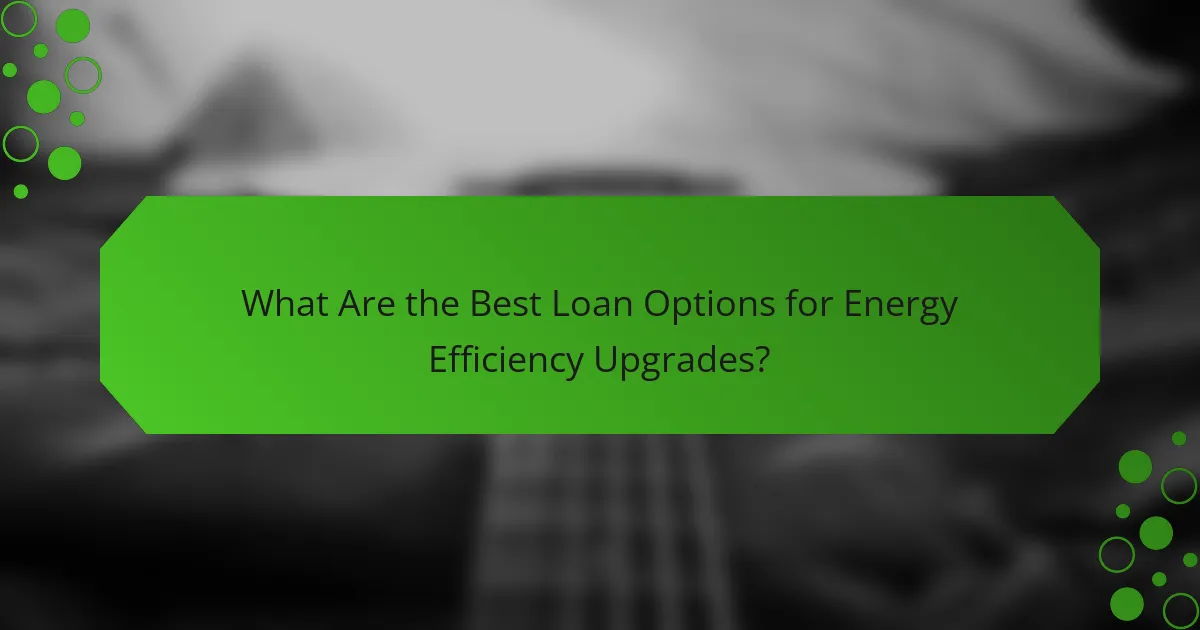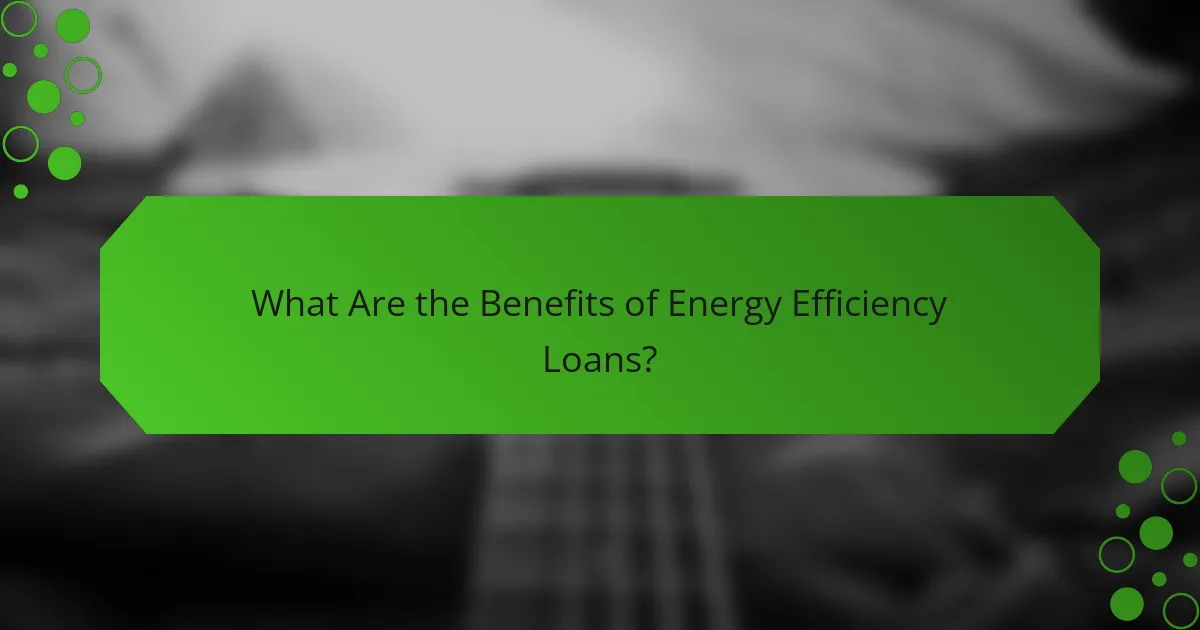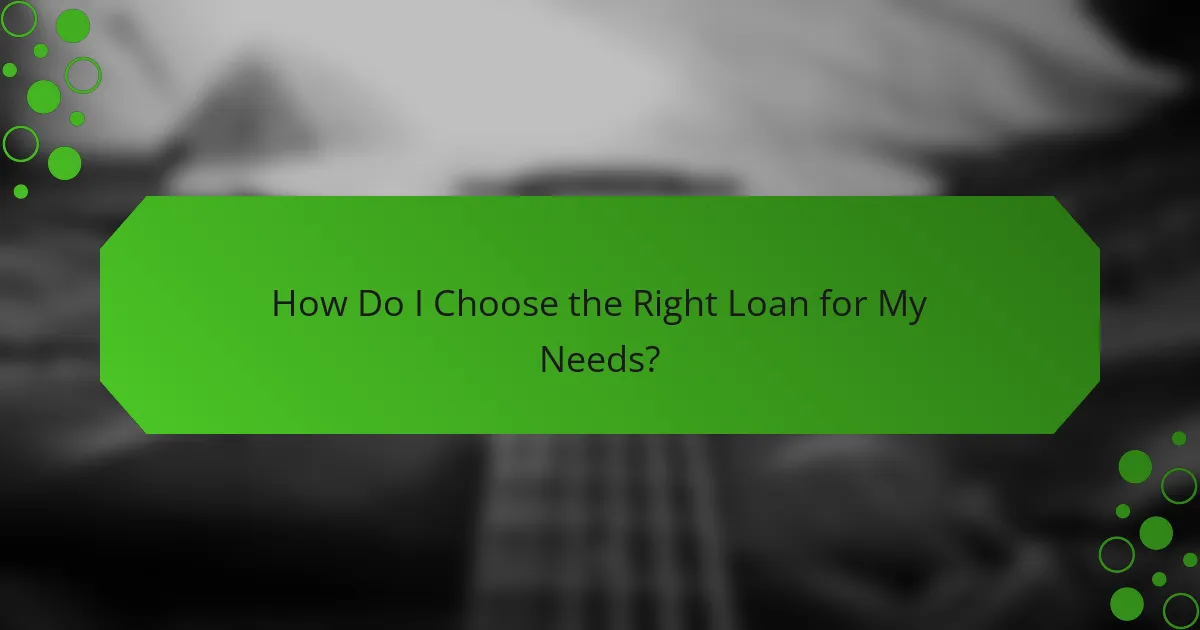Exploring loan options for energy efficiency upgrades can empower homeowners to make significant improvements while reducing energy costs. These specialized loans offer flexible terms and favorable conditions, making it easier to finance projects such as insulation, HVAC systems, and solar panel installations. By investing in energy-efficient upgrades, borrowers not only save money but also contribute to a more sustainable future.

What Are the Best Loan Options for Energy Efficiency Upgrades?
The best loan options for energy efficiency upgrades include specialized loans designed to finance home improvements that enhance energy efficiency. These loans can help homeowners access funds for projects like insulation, HVAC systems, and solar panels, often with favorable terms and benefits.
Home Energy Improvement Loans
Home energy improvement loans are specifically tailored for homeowners looking to make energy-efficient upgrades. These loans typically cover a range of projects, from installing energy-efficient windows to upgrading heating and cooling systems.
When considering these loans, look for competitive interest rates and flexible repayment terms. Some lenders may offer loans with no upfront costs, allowing you to pay for improvements over time while enjoying immediate energy savings.
Green Home Loans
Green home loans are designed for properties that meet specific energy efficiency standards, such as those certified by the U.S. Green Building Council. These loans often come with lower interest rates and can cover a variety of energy-efficient upgrades.
To qualify, homeowners may need to provide documentation of the energy efficiency improvements or certifications. These loans can be an excellent option for those looking to invest in sustainable living while reducing their overall energy costs.
Personal Loans for Energy Upgrades
Personal loans can be a flexible option for financing energy upgrades, as they can be used for any purpose, including home improvements. These loans typically have higher interest rates compared to specialized loans but offer quick access to funds.
When using personal loans for energy efficiency projects, ensure you compare rates from multiple lenders. Look for loans with no prepayment penalties, allowing you to pay off the loan early without incurring extra fees.
Government-Backed Loans
Government-backed loans, such as those offered through the Federal Housing Administration (FHA) or the U.S. Department of Agriculture (USDA), provide favorable terms for energy-efficient home upgrades. These loans often require lower down payments and have more lenient credit requirements.
Homeowners should check eligibility criteria and specific programs available in their area. These loans can significantly reduce the financial burden of making energy-efficient improvements, making them an attractive option for many homeowners.
Energy-Efficient Mortgages
Energy-efficient mortgages (EEMs) allow homeowners to finance energy-efficient upgrades as part of their mortgage. These loans enable borrowers to include the cost of improvements in their mortgage amount, often resulting in lower monthly payments.
To qualify for an EEM, homeowners typically need to demonstrate the projected energy savings from the upgrades. This type of financing can be particularly beneficial for those purchasing a new home or refinancing an existing mortgage while making energy-efficient improvements.

What Are the Terms of Energy Efficiency Loans?
Energy efficiency loans typically feature flexible terms that cater to various needs, making them accessible for homeowners and businesses looking to upgrade their systems. These loans can vary in duration, interest rates, repayment options, and eligibility criteria, allowing borrowers to find a suitable financial solution for their energy-saving projects.
Loan Duration
The duration of energy efficiency loans can range from a few years to over a decade, depending on the lender and the size of the loan. Shorter terms may lead to higher monthly payments but lower overall interest costs, while longer terms can reduce monthly payments but increase total interest paid. Borrowers should evaluate their budget and project scope to choose an appropriate loan duration.
Interest Rates
Interest rates for energy efficiency loans can vary significantly, often falling between 3% and 10%. Factors influencing these rates include the borrower’s credit score, the loan amount, and the lender’s policies. It’s advisable to shop around and compare offers from multiple lenders to secure the best possible rate.
Repayment Options
Repayment options for energy efficiency loans may include fixed monthly payments, interest-only payments for an initial period, or flexible payment plans based on income. Some lenders might offer incentives such as deferred payments or payment holidays during the project installation phase. Borrowers should carefully review these options to find a plan that aligns with their financial situation.
Eligibility Criteria
Eligibility for energy efficiency loans often depends on factors such as credit history, income level, and the specific energy efficiency project being financed. Many lenders require a minimum credit score and proof of income, while some programs may offer loans specifically for low-income households or specific energy-saving upgrades. Researching various programs can help identify the best fit for individual circumstances.

What Are the Benefits of Energy Efficiency Loans?
Energy efficiency loans provide financial support for upgrades that reduce energy consumption, leading to significant savings and environmental benefits. These loans often come with favorable terms and can help homeowners and businesses invest in sustainable improvements.
Lower Energy Bills
One of the primary benefits of energy efficiency loans is the reduction in energy bills. By financing upgrades such as better insulation, energy-efficient windows, or modern heating and cooling systems, borrowers can significantly decrease their monthly utility costs.
For example, homeowners who invest in energy-efficient appliances may see a reduction in their energy bills by 20-30%. This not only helps recover the loan costs over time but also improves overall financial stability.
Increased Property Value
Investing in energy efficiency can enhance property value. Homes equipped with energy-efficient features are often more attractive to buyers, as they promise lower operating costs and a reduced carbon footprint.
Studies suggest that energy-efficient upgrades can increase property values by 5-15%, depending on the local market and the extent of the improvements. This makes energy efficiency loans not just a cost-saving measure but also a smart investment in real estate.
Environmental Impact
Energy efficiency loans contribute to a positive environmental impact by reducing greenhouse gas emissions. Upgrading to energy-efficient systems lowers the demand for fossil fuels, which helps combat climate change.
For instance, by replacing an old furnace with a high-efficiency model, a household can reduce its carbon footprint significantly. This aligns with global efforts to promote sustainability and responsible energy use.
Access to Incentives
Many energy efficiency loans come with access to various incentives, such as tax credits or rebates. These incentives can further reduce the overall cost of upgrades, making them more affordable for borrowers.
For example, in the United States, homeowners may qualify for federal tax credits for certain energy-efficient improvements, which can cover a portion of the loan costs. It’s essential to research local and federal programs to maximize these benefits when considering energy efficiency financing.

How Do I Choose the Right Loan for My Needs?
Choosing the right loan for energy efficiency upgrades involves assessing your financial situation, comparing loan offers, and understanding the terms associated with each option. Focus on your budget, the total cost of the upgrades, and the potential savings on energy bills to make an informed decision.
Assessing Your Financial Situation
Start by evaluating your current financial health, including your income, expenses, and credit score. A good credit score can qualify you for lower interest rates, while a tight budget may limit your loan options.
Consider how much you can afford to borrow and repay monthly. A common rule of thumb is that your monthly loan payment should not exceed 15% of your monthly income. This ensures that you can manage your loan without straining your finances.
Comparing Loan Offers
Once you have a clear picture of your finances, gather loan offers from various lenders. Look for loans specifically designed for energy efficiency upgrades, as they often come with favorable terms.
Compare interest rates, fees, and repayment terms. A lower interest rate can save you money over the life of the loan, while longer terms may reduce your monthly payments but increase total interest paid. Create a simple comparison table to visualize these differences.
Understanding Loan Terms
Familiarize yourself with key loan terms such as interest rates, repayment periods, and any associated fees. Fixed-rate loans provide stability, while variable-rate loans may offer lower initial rates but can fluctuate over time.
Pay attention to any prepayment penalties, which can affect your ability to pay off the loan early without incurring extra costs. Understanding these terms helps you choose a loan that aligns with your financial goals and upgrade plans.

What Are the Prerequisites for Applying?
To apply for loans aimed at energy efficiency upgrades, you typically need to meet certain prerequisites that include a satisfactory credit score, proof of income, and a property appraisal. These factors help lenders assess your financial stability and the value of the property being upgraded.
Credit Score Requirements
Most lenders require a minimum credit score to qualify for energy efficiency loans. Generally, a score above 650 is considered favorable, but some programs may accept lower scores with additional conditions. A higher credit score can lead to better interest rates and loan terms.
Before applying, check your credit report for errors and consider improving your score if it falls below the required threshold. Simple actions like paying down existing debt or making timely payments can make a significant difference.
Income Verification
Income verification is crucial for lenders to ensure you can repay the loan. This usually involves providing recent pay stubs, tax returns, or bank statements. Self-employed individuals may need to submit additional documentation, such as profit and loss statements.
Be prepared to demonstrate stable income over a period of time, typically the last two years. Lenders may also consider your debt-to-income ratio, which should ideally be below 43% to qualify for most loan options.
Property Appraisal
A property appraisal assesses the current market value of your home and is often required for loan approval. This step ensures that the property is worth the amount you intend to borrow. Appraisals can cost several hundred dollars and usually take a few days to complete.
Keep in mind that the appraisal value can affect your loan amount. If the appraisal comes in lower than expected, you may need to adjust your loan request or provide a larger down payment. It’s wise to have a clear understanding of your property’s value before applying.
